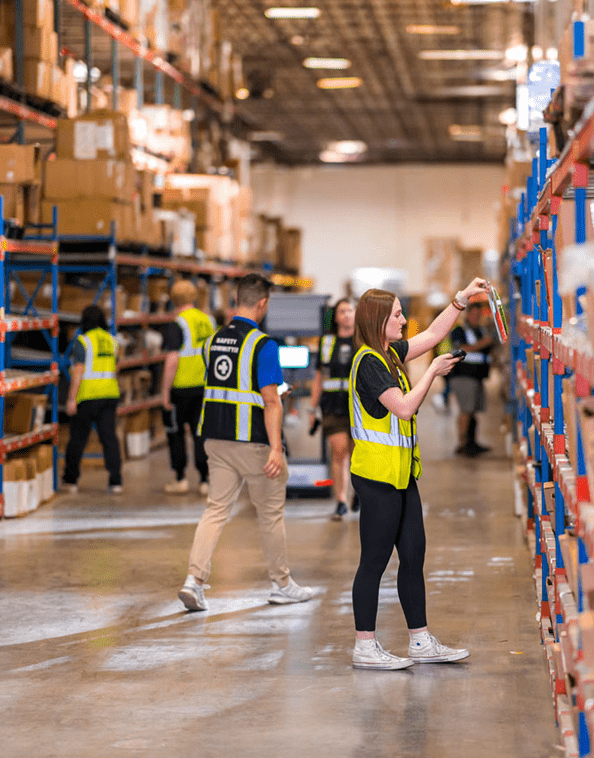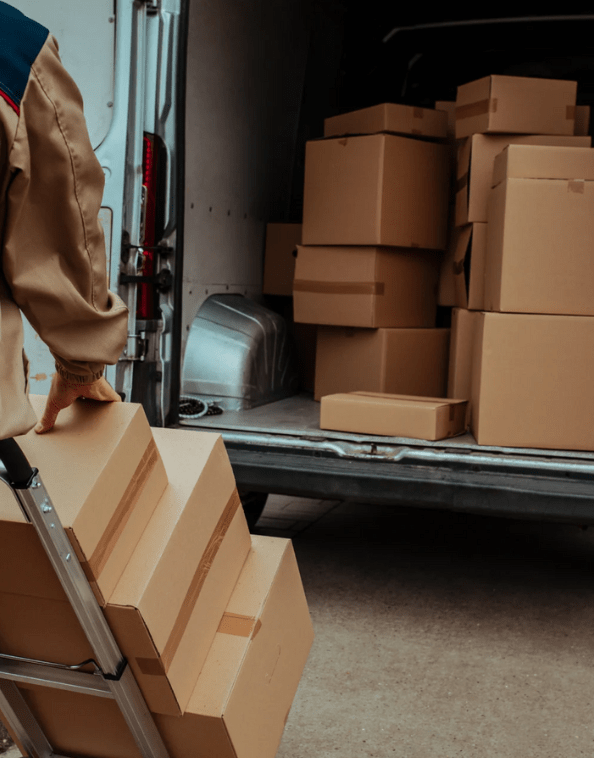Glossary
Glossary
A guide to key terms and concepts to help brands optimize fulfillment, logistics, and supply chain operations with FulfillMe.
What Is Fulfillment?
Fulfillment is the process of getting a product from your business to your customer. It involves a series of steps, including receiving orders, managing inventory, packaging products, and shipping them to the customer. Efficient fulfillment is crucial for eCommerce businesses as it directly impacts customer satisfaction and retention. By understanding the fulfillment process, businesses can streamline operations, reduce errors, and improve delivery times. To optimize fulfillment, many companies turn to third-party logistics (3PL) providers for a seamless, cost-effective solution. Learn more about how fulfillment works and explore leading fulfillment services.
What is a 3PL? Definition, Benefits & How It Works
A 3PL (third-party logistics provider) is a company that helps businesses manage and streamline their supply chain, warehousing, fulfillment, and shipping operations. By outsourcing logistics to a 3PL, companies can reduce costs, improve efficiency, and scale their operations without investing in their own infrastructure.
3PL providers offer a range of services, including inventory management, order fulfillment, freight forwarding, and last-mile delivery, allowing businesses to focus on growth while ensuring seamless logistics. Whether you’re an eCommerce store, manufacturer, or retailer, a 3PL can help optimize your shipping speed, storage, and distribution to meet customer demands efficiently.
What Is eCommerce?
Ecommerce, or “electronic commerce,” refers to the buying and selling of goods and services online. The internet enables individuals and businesses to trade physical products, digital goods, and services conveniently and securely.
Many businesses operate exclusively online, while others use ecommerce to enhance the reach of their existing distribution channels. Regardless of the approach, ecommerce continues to grow rapidly and offers significant profit potential. In this article, we’ll explore how ecommerce works and help you determine if it’s the right business model for you.
What is pick and pack fulfillment?
Pick and pack is a warehouse fulfillment process where items are selected (picked) from inventory and then securely packed into boxes for shipping. This method is widely used in e-commerce, retail, and third-party logistics (3PL) to ensure fast and accurate order fulfillment.
A well-optimized pick and pack system reduces shipping errors, lowers fulfillment costs, and improves customer satisfaction. Businesses can streamline this process by implementing efficient warehouse layouts, barcode scanning, automation, and inventory management software.
How to Ship a Package USPS
Shipping a package with USPS is simple and cost-effective. Choose a service like Priority Mail for fast delivery, First-Class Mail for lightweight items, or Media Mail for books. Securely package your item, label it clearly, and purchase postage online or at a USPS location. Online options like USPS.com or third-party services offer discounted rates.
Once ready, drop off your package at a post office, a collection box, or schedule a free USPS pickup. Most services include tracking, and you can add insurance or signature confirmation for extra security. Following these steps ensures a smooth, reliable shipping experience.
What Is Tariff?
A tariff is a tax on imported or exported goods, set by governments to control trade, protect domestic industries, and generate revenue.
What Is Warehouse?
A warehouse is a large facility designed for the storage, management, and distribution of goods, raw materials, or inventory. It is typically equipped with racks, shelves, and specialized handling equipment such as forklifts and conveyor systems to facilitate efficient organization and movement of products. Warehouses play a crucial role in supply chains, serving as hubs where goods are received, sorted, stored, and eventually shipped to retailers, businesses, or consumers. They can vary in size and function, ranging from small storage units to massive distribution centers that handle large volumes of inventory for e-commerce, manufacturing, or logistics companies.
What is dropshipping & does it work in 2025?
Dropshipping is an easy-to-start e-commerce business model with low barriers to entry. By partnering with suppliers who handle fulfillment and logistics, you can concentrate on sales, customer service, and scaling your business.
In this comprehensive dropshipping guide, you’ll discover how to start and grow a successful e-commerce business.
What is a Delivery Area Surcharge (DAS) and How is it Calculated?
A Delivery Area Surcharge (DAS) is an extra fee charged by shipping carriers like FedEx and UPS for deliveries to specific ZIP codes, typically in remote or less densely populated areas, or to residential addresses. This surcharge helps carriers cover the additional costs of reaching these locations, which often involve longer distances, more complex logistics, and extra handling. DAS applies to both residential deliveries and shipments to areas outside a carrier’s standard service zones.
The calculation of DAS is influenced by several factors. The main considerations include the distance from the carrier’s nearest hub or distribution center, the type of delivery (residential vs. commercial), and the specific ZIP code of the destination. Remote locations or areas farther from major shipping hubs tend to incur higher surcharges. Additionally, some carriers may have different rates based on the service level, such as expedited or ground shipping. These factors all contribute to the cost of delivering to less accessible locations.
What Is Arbitrage?
Arbitrage is the practice of exploiting price differences in different markets or platforms to profit from buying and selling assets, securities, or goods.
This strategy capitalizes on market inefficiencies where the same asset is priced differently due to supply and demand shifts, transaction costs, or currency fluctuations. Traders and investors use automated trading, real-time data, and AI-driven analytics to seize these opportunities before price discrepancies disappear.
Common types include retail arbitrage, where products are bought at a lower price and resold for profit, and financial arbitrage, which exploits price gaps in stocks, commodities, forex, or cryptocurrency markets. While arbitrage can be profitable, it requires speed, precision, and an understanding of market dynamics to succeed.
What Is Dunnage?
Dunnage refers to the protective packaging materials used to secure and cushion products during shipping. Common types of dunnage include bubble wrap, air pillows, foam inserts, packing peanuts, corrugated paper, and heavy-duty plastic supports—each designed to prevent items from shifting, breaking, or getting damaged in transit. In ecommerce fulfillment, using the right dunnage helps reduce return rates, protect fragile goods, and ensure a positive unboxing experience for customers.
To be effective, dunnage should be paired with properly sized packaging. For example, placing a small item in an oversized shipping box filled with excess dunnage can increase shipping costs and waste. Likewise, fragile or high-value products should never be sent in a thin bubble mailer without adequate protection. Choosing the right combination of shipping materials, box dimensions, and dunnage is essential for safe, cost-efficient delivery and a professional brand presentation.
What Is Seller Central?
Seller Central is Amazon’s comprehensive web platform designed for managing your selling account, inventory, and product listings. It provides a centralized hub where sellers can monitor sales performance, fulfill customer orders, adjust pricing, and track their business growth. With a range of tools and features, Seller Central helps sellers optimize operations and streamline their processes. Available for both individual sellers and businesses, it’s the key to successfully reaching Amazon’s vast customer base and growing your business on the marketplace.
What Is a Delivery Exception? Meaning, Causes, and How to Fix It
A delivery exception occurs when a package encounters an unexpected delay that prevents it from reaching its destination on time. Common causes include incorrect or incomplete addresses, severe weather disruptions, customs holds for international shipments, or the recipient being unavailable at the time of delivery. Carriers like FedEx, UPS, and USPS provide tracking updates that specify the reason for the exception, helping senders and recipients understand the issue.
To resolve a delivery exception, start by checking the tracking details for more information. If the address is incorrect, update it with the carrier as soon as possible. In cases of weather delays or customs holds, waiting for further updates may be necessary. If the recipient was unavailable, many carriers allow rescheduling or pickup at a local facility. Proactively monitoring shipments and communicating with the carrier can help minimize disruptions and ensure a smoother delivery process.
What is Dimensional Weight? How to Calculate
Dimensional weight, also known as volumetric weight, is a pricing method used by shipping carriers to calculate shipping costs based on the volume of a package rather than its actual weight. This is especially useful for large but lightweight items that take up more space in transit, like pillows, blankets, or large retail products. Shipping companies like UPS, FedEx, and DHL use dimensional weight to optimize their space and ensure that they charge fairly for the space packages occupy, particularly in air freight and courier services. By factoring in both size and weight, dimensional weight pricing helps logistics companies manage capacity more efficiently and fairly distribute shipping costs.
To calculate dimensional weight, you multiply the length, width, and height of the package (in inches or centimeters), and then divide the result by a dimensional divisor. For example, if a package measures 20 inches by 15 inches by 10 inches and the divisor is 166, the dimensional weight would be 18.07 lbs. If the actual weight is lighter than the dimensional weight, the shipping carrier will charge based on the higher dimensional weight. This pricing method ensures that carriers can manage their logistics network effectively, particularly for large shipments or air cargo, where space is more valuable than weight.
Waht is ShipMonk?
ShipMonk is a cloud-based third-party logistics (3PL) platform that provides e-commerce fulfillment services for online retailers. The platform supports inventory management, order processing, warehouse operations, and shipping logistics. ShipMonk integrates with popular e-commerce platforms such as Shopify, Amazon, WooCommerce, and BigCommerce to help automate and manage fulfillment workflows.
With multiple warehouse locations, ShipMonk enables domestic and international shipping, offering solutions for storage, picking and packing, and last-mile delivery. The service is commonly used by direct-to-consumer (DTC) brands, subscription box companies, and marketplace sellers seeking outsourced logistics and scalable fulfillment infrastructure.
What is ShipStation?
ShipStation is a powerful web-based shipping platform designed to streamline small parcel shipping and e-commerce fulfillment. Ideal for businesses looking to efficiently manage product deliveries to customers, ShipStation provides an easy solution for shipping needs. However, it’s important to note that it may not be suitable for managing inbound inventory at freight levels. As a SaaS (Software-as-a-Service) solution, ShipStation doesn’t require any specific hardware or installations, making it easy to integrate into your existing system.
ShipStation operates on a subscription-based model, where businesses pay a monthly fee depending on shipment volume and other factors. In the U.S., it’s becoming an increasingly popular tool for small businesses as they scale. In this review, we’ll explore whether ShipStation is the right solution for your business, dive into its features, and highlight potential concerns expressed by its users.
What is an Inventory Discrepancy
An inventory discrepancy occurs when there’s a mismatch between the recorded stock levels in your system and the actual physical inventory on hand. This can happen for a variety of reasons, such as data entry mistakes, miscounts during receiving or cycle counts, or barcode scanning errors. Inventory shrinkage—caused by theft, damage, or lost items—can also lead to discrepancies. In many cases, discrepancies arise from poor communication between systems or delays in syncing data between an ecommerce platform and a warehouse management system (WMS).
Inventory discrepancies can have a ripple effect on ecommerce operations. When stock levels are inaccurate, businesses risk overselling items they don’t have or holding excess stock that isn’t needed. This can result in fulfillment delays, order cancellations, or negative customer experiences—all of which impact revenue and brand trust. To minimize discrepancies, ecommerce businesses should regularly audit inventory, integrate real-time tracking tools, and ensure teams are trained to follow consistent processes.



